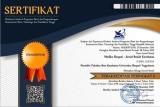POLIMORFISME GEN TRANSFERIN P570S TERHADAP KADAR HEMOGLOBIN (HB) PADA REMAJA PUTRI PONDOK PESANTREN DI YOGYAKARTA
Abstract
Transferrin P570s. Gene Polymorphism Against Hemoglobin (Hb) Levels in Adolescent Girls Islamic Boarding Schools In Yogyakarta
Background: Anemia in adolescent girls is one of the nutrients problem. Transferin P570S gene polymorphism has an effect on glycosylated transferin so it can accelerate the degradation transferin. This can cause a decrease in transferrin function and interfere Fe homeostasis. The lack of Fe intake is one cause of the anemia. Objectives: To investigate correlation P570S transferrin gene polymorphisms with iron status as risk factor for iron deficiency anemia in adolescent girls. Methods: Desain of this study was case control. Eighty one adolescent girls living in the boarding school were included in this study. Blood samples used for biochemical examination of the blood and to detect the presence of P570S transferin polymorphism. Genotype frequencies between groups were analyzed using Chi square test and calculated the Odds Ratio (OR). Comparison of the mean rate of hemoglobin between genotype groups were analyzed statistically using One-way ANOVA test. Results: Transferin P570S polymorphism frequency in anemic girls with the CC was 68.4%, CT was 26.3%, TT was 5.3%, C allele frequency= 81.6% and T allele= 18.4%. The odds ratio (OR) P570S transferrin gene polymorphisms for polymorphic genotypes of 0.783 and for the T allele is 0.991. On the subject of anemia with polymorphic genotypes have hemoglobin levels 11.45 while wild type 11.6 (p= 0.000). On the subject of IDA with polymophic genotypes have hemoglobin levels 11.45 while wild type genotype 11.6 (p= 0.190). Conclusion: Genotype frequencies P570S transferring gene polymorphism in adolescent girls at the boarding school who suffer anemia of 31.6% and 35.7% of IDA. The mean hemoglobin levels in subjects with polymorphic genotype lower than the wild type.
Keywords
Full Text:
PDFReferences
Badan Penelitian dan Pengembangan Kesehatan. (2018). Laporan Riset Kesehatan Dasar Nasional Tahun 2018. Badan Penelitian Dan Pengembangan Kesehatan, p. 198. Retrieved from http://labdata.litbang.kemkes.go.id/images/download/laporan/RKD/2018/Laporan_Nasional_RKD2018_FINAL.pdf
Badan Penelitian dan Pengembangan Kesehatan. (2019). Laporan Riset Kesehatan Dasar Provinsi Jawa Barat Tahun 2018. In Lembaga Penerbit Badan Penelitian dan Pengembangan Kesehatan.
Bahjuri, P., Ardhiantie, Arifi, M. dzulfikar, Trisnantoro, L., Handono, D., Kurniawan, M. F., … Nirmalasari, E. (2017). Modul Sinkronisasi RPJMD-RPJMN Bidang Kesehatan dan Gizi Masyarakat. 129.
Brander, R. L., Pavlinac, P. B., Walson, J. L., John-Stewart, G. C., Weaver, M. R., Faruque, A. S. G., Kotloff, K. L. (2019). Determinants of linear growth faltering among children with moderate-to-severe diarrhea in the Global Enteric Multicenter Study. BMC Medicine, 17(1), 214. https://doi.org/10.1186/s12916-019-1441-3
Ernawati, F., Prihatini, M., & Yuriestia, A. (2016). Gambaran Konsumsi Protein Nabati Dan Hewani Pada Anak Balita Stunting Dan Gizi Kurang Di Indonesia (The Profile of Vegetable - Animal Protein Consumption of Stunting and Underweight Children Under Five Years Old in Indonesia). Nutrition and Food Research, 39(2), 95–102. https://doi.org/10.22435/pgm.v39i2.6973.
Firman, A. N., & Mahmudiono, T. (2018). Kurangnya Asupan Energi dan Lemak yang Berhubungan dengan Status Gizi Kurang pada Balita Usia 25-60 Bulan. The Indonesian Journal of Public Health, 13(1), 48–58.
Heryani, E. (2021). The Effect of Nutrition Food Diversity Assistance on Weight Gain of Undernourished Toddlers at Jambi City. First International Conference on Health, Social Sciences and Technology (ICOHSST 2020), 278–281. Atlantis Press.
Joseph, S. A., Casapía, M., Blouin, B., Maheu-Giroux, M., Rahme, E., & Gyorkos, T. W. (2014). Risk factors associated with malnutrition in one-year-old children living in the Peruvian Amazon. PLoS Neglected Tropical Diseases, 8(12), e3369–e3369. https://doi.org/10.1371/journal.pntd.0003369
Kartasapoetra, G., & Marsetyo, H. (2008). Ilmu gizi: Korelasi gizi, kesehatan, dan produktivitas kerja.
Kementrian Kesehatan RI. (2020). Indikator Program Kesehatan Masyarakat Dalam RPJMN dan Renstra Kementerian Kesehatan Tahun 2020-2024. Kemenkes RI.
Khamis, A. G., Mwanri, A. W., Ntwenya, J. E., & Kreppel, K. (2019). The influence of dietary diversity on the nutritional status of children between 6 and 23 months of age in Tanzania. BMC Pediatrics, 19(1). https://doi.org/10.1186/s12887-019-1897-5
Lestari, N. D. (2016). Analisis Determinan Gizi Kurang pada Balita di Kulon Progo. Yogyakarta, 1(1), 15–21.
Moursi, M. M., Arimond, M., Dewey, K. G., Trè, S., Ruel, M. T., & Delpeuch, F. (2008). The Journal of Nutrition Community and International Nutrition Dietary Diversity Is a Good Predictor of the Micronutrient Density of the Diet of 6-to 23-Month-Old Children in Madagascar 1-3. J. Nutr, 138, 2448–2453. https://doi.org/10.3945/jn.108.093971
Muhoozi, G. K. M., Atukunda, P., Mwadime, R., Iversen, O., & Westerberg, A. C. (2016). Nutritional and developmental status among 6-to 8-month-old children in southwestern Uganda: a cross-sectional study. https://doi.org/10.3402/fnr.v60.30270
Pratiwi, R. H., Suyatno, S., & Aruben, R. (2015). Faktor-faktor yang berhubungan dengan berat-kurang (underweight) pada balita di perkotaan dan perdesaan Indonesia berdasarkan data Riskesdas tahun 2013. Jurnal Kesehatan Masyarakat (e-Journal), 3(2), 127–137.
Rahim, F. K. (2014). Faktor risiko underweight balita umur 7-59 bulan. KEMAS: Jurnal Kesehatan Masyarakat, 9(2), 115–121.
Rodríguez, L., Cervantes, E., & Ortiz, R. (2011). Malnutrition and gastrointestinal and respiratory infections in children: a public health problem. International Journal of Environmental Research and Public Health, 8(4), 1174–1205.
Scaglioni, S., Arrizza, C., Vecchi, F., & Tedeschi, S. (2011). Determinants of children’s eating behavior. The American Journal of Clinical Nutrition, 94(suppl_6), 2006S-2011S.
Utami, N. W., & Rahmawati, D. (2020). Frekuensi Makan, Asupan Energi Dan Protein Terhadap Status Gizi Pada Balita Di Puskesmas Minggir Sleman. INVOLUSI: Jurnal Ilmu Kebidanan, 10(2), 56–61.
Yunitasari, A. R., Sartika, R. A. D., Setiarini, A., & Irwan, R. B. (2020). Household Factors Associated with Underweight in Children 24-59 Month in Urban and Rural in Indonesia. 16(1), 140–151.
DOI: https://doi.org/10.35842/mr.v16i3.545
Article Metrics
Abstract view : 174 ViewPDF - 38 View
Refbacks
- There are currently no refbacks.
Copyright (c) 2021 Medika Respati : Jurnal Ilmiah Kesehatan
Medika Respati : Jurnal Ilmiah Kesehatan indexed by:








